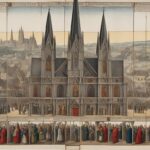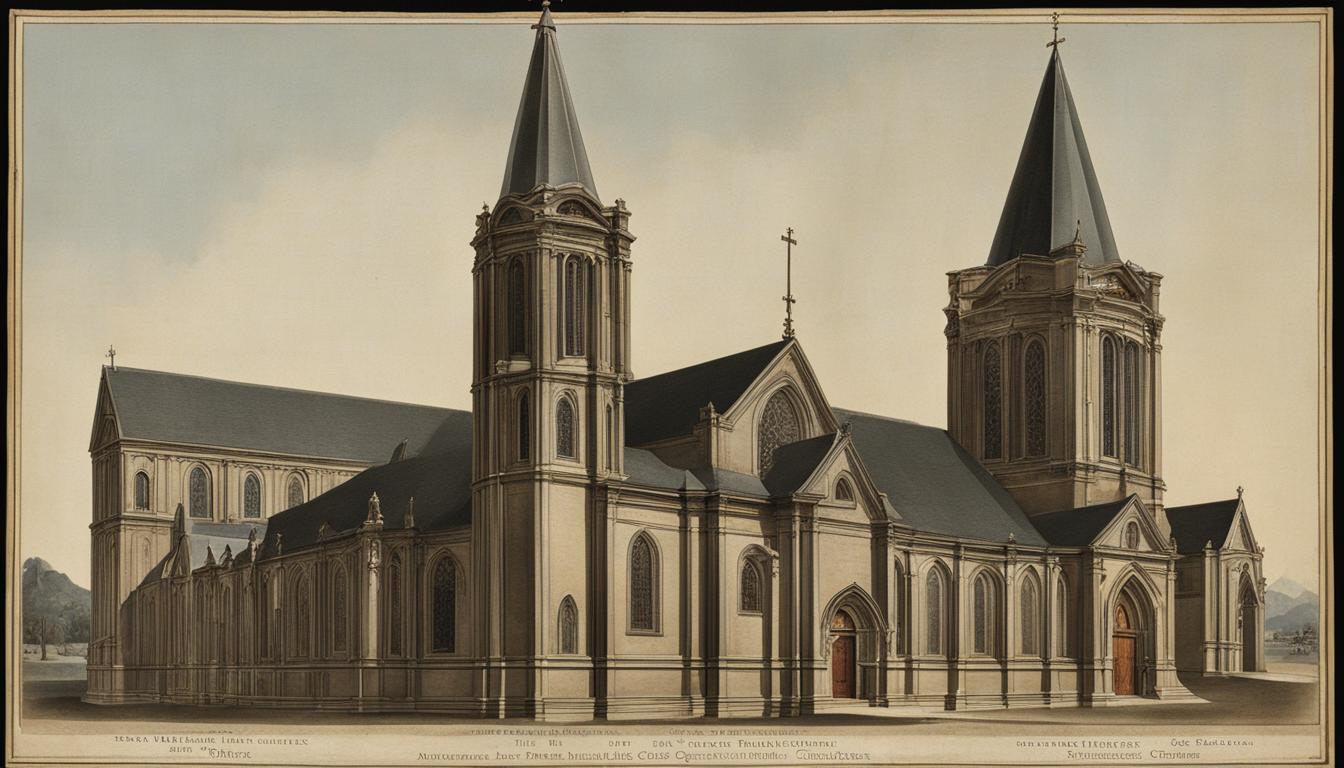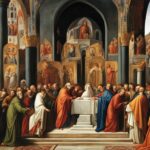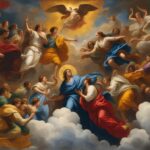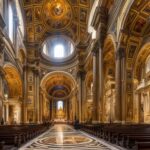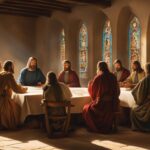Christianity, with its rich and fascinating history spanning over two thousand years, can be traced back to the life, teachings, death, and resurrection of Jesus Christ. This faith has influenced countless individuals and shaped human civilization. In this article, we will embark on a journey through the origins and growth of the early Christian Church, exploring key events, prominent figures, and the lasting legacy of Christianity.
Key Takeaways:
- Christianity’s origins can be traced back to the life and teachings of Jesus Christ.
- Early Christians faced severe persecution from the Roman Empire.
- Emperor Constantine played a significant role in the rise of Christian influence.
- The Great Schism led to the division between the Eastern Orthodox Church and the Roman Catholic Church.
- The Reformation movement led to the birth of Protestantism and challenged the authority of the Roman Catholic Church.
The Life and Teachings of Jesus Christ
The life and teachings of Jesus Christ form the foundation of Christianity. Born in Bethlehem, Jesus grew up in Nazareth and began his ministry around the age of 30. He preached about God’s kingdom, performed miracles, and called his followers to love one another. The Gospels provide detailed accounts of Jesus’ parables, his interactions with people from all walks of life, and his ultimate sacrifice for humanity.
Jesus’ teachings emphasized love, compassion, and forgiveness. He urged his followers to treat others as they would like to be treated and to show kindness even to their enemies. Jesus’ message resonated with people, and multitudes flocked to hear him speak. He presented a radical departure from traditional religious practices, focusing on internal transformation rather than external rituals.
One of Jesus’ most powerful teachings was his commandment to love one another as he loved them. This message of unconditional love has become a central tenet of Christianity, shaping the way believers interact with others and guiding their moral compass. Jesus’ life and teachings continue to inspire and challenge individuals to strive for a more compassionate and inclusive world.
The Sermon on the Mount
“Blessed are the meek, for they will inherit the earth. Blessed are those who hunger and thirst for righteousness, for they will be filled. Blessed are the peacemakers, for they will be called children of God.” – Matthew 5:5-9
The Sermon on the Mount, found in the Gospel of Matthew, is one of Jesus’ most renowned teachings. In this sermon, Jesus delivered a series of blessings known as the Beatitudes, which describe the qualities and attitudes that lead to true happiness and spiritual fulfillment. The Beatitudes challenge individuals to embrace humility, seek justice, pursue peace, and display mercy. They serve as a roadmap for living a life of righteousness and deepening one’s relationship with God.
The Parable of the Good Samaritan
“But a Samaritan, as he traveled, came where the man was; and when he saw him, he took pity on him. He went to him and bandaged his wounds, pouring on oil and wine. Then he put the man on his own donkey, brought him to an inn and took care of him.” – Luke 10:33-34
The Parable of the Good Samaritan highlights the importance of compassion and kindness towards others. In this story, Jesus illustrates how a despised and marginalized Samaritan demonstrates true neighborly love by helping a wounded stranger, while others pass by without offering assistance. The parable challenges individuals to broaden their definition of “neighbor” and to show compassion to all, regardless of their background or social status.
| Key Teachings of Jesus Christ |
|---|
| Love one another |
| Show compassion and mercy |
| Forgive others |
| Seek first the kingdom of God |
| Practice humility |
| Pursue justice and righteousness |
The Early Church and Persecution
The early Christian Church faced significant persecution during its formative years. Despite the challenges, the faith continued to grow, fueled by the dedication and resilience of its followers.
During the first few centuries after the crucifixion of Jesus Christ, Christians faced hostility from the Roman Empire. The Romans saw Christianity as a threat to their power and authority, leading to widespread persecution of believers. Christians were subjected to torture, imprisonment, and even death for their refusal to renounce their faith.
The persecution served to strengthen the resolve of early Christians, who viewed suffering for their beliefs as a badge of honor. They formed tight-knit communities and relied on each other for support and encouragement. The resilience of these early believers laid the foundation for the growth and spread of Christianity.
“The blood of the martyrs is the seed of the Church.”
This famous quote from the early Christian theologian Tertullian reflects the impact of persecution on the growth of the Church. The willingness of Christians to endure suffering and sacrifice their lives for their faith inspired others to embrace Christianity, leading to the expansion of the Church beyond the Roman Empire.
| Effects of Early Christian Persecution | Key Figures | Significant Events |
|---|---|---|
| Strengthened the faith of believers | Perpetua, Felicity, Ignatius of Antioch | The Great Fire of Rome, Nero’s persecution, Diocletian’s persecution |
| Contributed to the spread of Christianity | Polycarp, Justin Martyr, Tertullian | The Edict of Milan, Constantine’s conversion |
| Established a tradition of martyrdom | Stephen, Lawrence, Agnes | The Council of Nicaea, the formation of the early Church councils |
The persecution faced by the early Church ultimately played a crucial role in shaping the development of Christianity. It solidified the commitment and devotion of believers, provided opportunities for new converts to witness the faith in action, and contributed to the spread of Christianity to the far corners of the world.
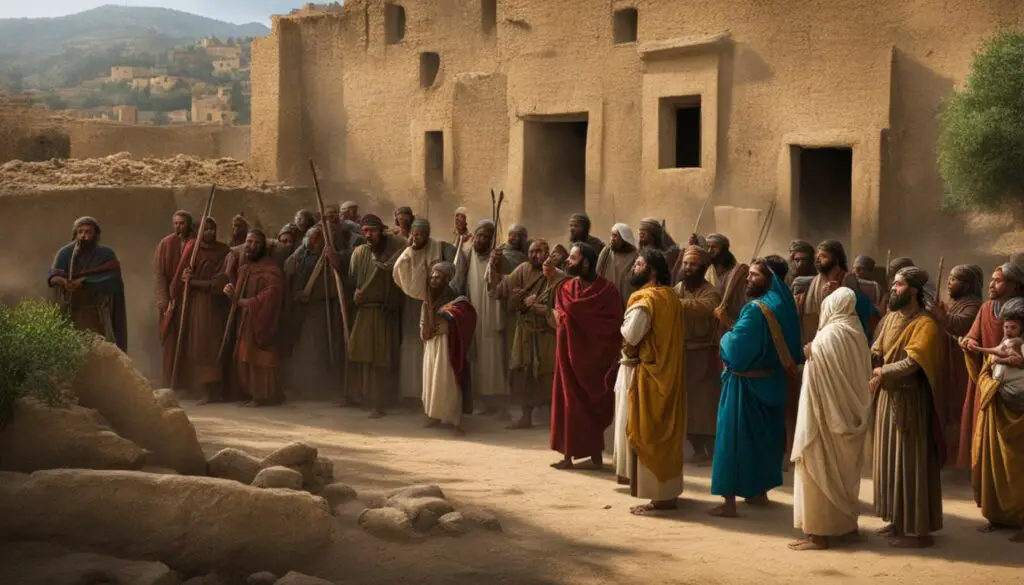
The Legacy of Persecution
The legacy of early Christian persecution can still be seen in the present-day Church. The stories of martyrdom and persecution serve as a reminder of the sacrifices made by those who came before, inspiring modern Christians to stand firm in their faith and defend religious freedom.
Today, the early Church’s example of perseverance in the face of adversity continues to inspire believers around the world. It serves as a testament to the transformative power of faith and the enduring impact of Christianity on individuals and societies.
Constantine and the Rise of Christian Influence
In the early fourth century, a significant turning point occurred in the history of Christianity with the conversion of Emperor Constantine. Constantine’s embrace of Christianity had a profound impact on the religion, leading to the rise of Christian influence and shaping the course of the faith for centuries to come.
With Constantine’s conversion came the legalization of Christianity, putting an end to the widespread persecution faced by early Christians. This newfound acceptance allowed the faith to flourish, as churches were granted legal status and paganism gradually gave way to Christian worship. Constantine’s support of Christianity also paved the way for the religion to become the state religion of the Roman Empire.
“In this sign, conquer!” – Constantine
The rise of Christian influence under Constantine’s rule extended beyond religious freedom. The emperor played a critical role in shaping Christian doctrine and practice, convening the Council of Nicaea in 325 AD to address theological disputes. The Council produced the Nicene Creed, which established a standardized statement of faith and defined key Christian beliefs, including the divinity of Jesus Christ. These efforts to unify Christian teachings further solidified the religion’s influence and set the stage for its continued growth and development.
Table: The Impact of Constantine’s Conversion on Christianity
| Aspect | Before Constantine | After Constantine |
|---|---|---|
| Legal Status | Illegal and persecuted | Legal and protected |
| State Support | Paganism | Christianity |
| Doctrine | Varied interpretations | Standardized beliefs, Nicene Creed |
| Religious Art and Architecture | Marginalized | Flourished, influenced by Christian themes |
This table illustrates the transformative impact of Constantine’s conversion on various aspects of Christianity. With the newfound legal status, the faith could spread without fear of persecution, leading to its rapid expansion. State support also meant that Christianity could now shape legislation and influence cultural norms, resulting in the integration of Christian themes into art, architecture, and societal practices.
Constantine’s conversion marked a crucial turning point in the history of Christianity. It not only ensured the survival and growth of the faith but also advanced its influence in profound ways. The legalization of Christianity and its subsequent rise to state religion status laid the groundwork for Christianity to become one of the most influential religions in the world, shaping societies, cultures, and individuals for centuries to come.
The Great Schism: East and West Divide
The Great Schism, also known as the East-West Schism, was a significant event in Christian history that led to the permanent division between the Eastern Orthodox Church and the Roman Catholic Church. This split occurred in the 11th century and had profound theological, cultural, and political implications, shaping the development of Christianity in the East and the West.
The Great Schism was the culmination of tensions that had been growing between the churches of Rome and Constantinople for centuries. The primary cause of the division was the question of papal authority and the role of the bishop of Rome, also known as the Pope. The Eastern Orthodox Church rejected the supremacy of the Pope and maintained the autonomy of its patriarchs, while the Roman Catholic Church upheld the authority of the Pope as the successor of Saint Peter.
The division between East and West was further exacerbated by differences in liturgical practices, theological interpretations, and cultural traditions. The use of the Latin language in the West and the Greek language in the East added another layer of distinction. Ultimately, the Great Schism led to the establishment of two distinct branches of Christianity, each with its own hierarchy, rituals, and doctrinal beliefs.
| Eastern Orthodox Church | Roman Catholic Church |
|---|---|
| Headed by patriarchs and bishops | Headed by the Pope |
| Emphasizes the importance of tradition and mysticism | Emphasizes the authority of the Pope and the sacraments |
| Uses the Greek language in liturgy | Uses the Latin language in liturgy |
| Allows married priests | Requires celibacy for priests |
“The division between the Eastern Orthodox Church and the Roman Catholic Church during the Great Schism was a significant turning point in the history of Christianity, shaping the religious landscape of the Eastern and Western worlds.”
The Great Schism continues to have an impact on Christianity to this day. While efforts have been made towards reconciliation and dialogue between the two branches, the theological, cultural, and historical differences remain. Understanding the Great Schism is essential for an in-depth exploration of the development of Christianity and its diverse traditions.
Medieval Christianity and the Crusades
In the medieval period, Christianity held a central position in European society, influencing various aspects of life including politics, economics, and religion. The Roman Catholic Church, an institution of great power during this time, played a significant role in shaping the beliefs and practices of Christians. It was also during this period that the Crusades took place, leaving a lasting impact on both the Christian and Muslim worlds.
The Crusades were a series of holy wars initiated by Christians with the goal of gaining control over the holy sites in the Middle East. These military campaigns were motivated by religious fervor and the desire to protect and expand Christianity. While the Crusades were marked by periods of success and failure, they had far-reaching consequences, both positive and negative.
One of the positive outcomes of the Crusades was the exchange of knowledge and ideas between different cultures. As Christians journeyed to the East, they encountered new technologies, philosophies, and cultural practices. This exchange of information helped to enrich European society, leading to advancements in areas such as science, trade, and architecture.
The Reformation: Martin Luther and Protestantism
The Reformation, led by Martin Luther in the 16th century, marked a significant turning point in the history of Christianity. Dissatisfied with the corruption and excesses of the Roman Catholic Church, Luther challenged the authority and practices of the church with his Ninety-Five Theses. This document, critical of the sale of indulgences, ignited a movement that questioned long-held beliefs and led to the birth of Protestantism.
Luther’s central teachings included the belief in justification by faith alone, the priesthood of all believers, and the authority of Scripture as the ultimate source of religious truth. These ideas resonated with many who sought a more personal and direct connection with God, as well as those who were disillusioned by the Catholic Church’s dominance and opulence. The Reformation spread rapidly throughout Europe, leading to the establishment of various Protestant denominations.
The Impact of the Reformation
“Here I stand, I can do no other.”
The Reformation had far-reaching effects on both religious and secular spheres. It sparked widespread religious and social upheaval, challenging the political and religious authority of the Catholic Church. The Protestant movement led to the fragmentation of Christianity into multiple denominations, each with its own interpretations of the Bible and practices of worship.
The Reformation also had profound effects on education, literacy, and the spread of ideas. Protestant leaders advocated for the translation of the Bible into vernacular languages, making it accessible to a wider audience and promoting literacy. This emphasis on education laid the groundwork for the development of modern education systems in Protestant countries.
| Key Figures | Major Protestant Denominations |
|---|---|
| Martin Luther | Lutheranism |
| John Calvin | Calvinism |
| Huldrych Zwingli | Zwinglianism |
| Anglicanism (Church of England) | Anglicanism |
Today, the legacy of the Reformation continues to shape modern Christianity. The principles of religious freedom, individual interpretation of Scripture, and the importance of personal faith are prominently upheld by Protestant churches worldwide. The Reformation not only transformed Christianity but also had a profound impact on the development of democratic principles, the rise of capitalism, and the religious landscape as a whole.

Christianity’s Influence on Art and Culture
Christianity has had a profound impact on art and culture throughout history. From the earliest days of the faith, Christians have used various forms of artistic expression to communicate their beliefs, depict biblical stories, and inspire devotion. The fusion of religious themes and artistic creativity has given rise to some of the most iconic works of art in human history.
Artistic Representations of Christian Themes
Christianity’s influence on art can be seen in the countless paintings, sculptures, and stained glass windows that adorn churches, cathedrals, and museums around the world. These works of art often depict religious figures, biblical scenes, and religious symbolism, serving as visual representations of Christian teachings and stories. For example, Leonardo da Vinci’s iconic painting, “The Last Supper,” portrays the final meal of Jesus and his disciples, capturing the emotional intensity of the moment and inviting viewers to contemplate its significance.
“Art enables us to find ourselves and lose ourselves at the same time.” – Thomas Merton
Christian art has not only depicted biblical stories but has also served as a means of spiritual expression and worship. The intricate mosaics of Byzantine churches, the awe-inspiring architecture of Gothic cathedrals, and the celestial melodies of Gregorian chant all create a sacred atmosphere that invites contemplation, devotion, and connection to the divine.
Christianity’s Influence on Literature and Music
Christianity’s influence extends beyond visual art to literature and music as well. The Bible itself has been a source of inspiration for countless writers, poets, and playwrights throughout history. The works of authors such as Dante Alighieri, John Milton, and Fyodor Dostoevsky reflect the profound impact of Christian themes on literature, exploring spiritual journeys, moral dilemmas, and the human condition.
In the realm of music, Christianity has inspired composers to create masterpieces that evoke deep emotions and spiritual reflection. From the soaring choral compositions of Johann Sebastian Bach to the hauntingly beautiful hymns of hymn writers like Charles Wesley, Christian music has touched the hearts and souls of listeners for generations.
| Art Form | Notable Examples |
|---|---|
| Painting | Leonardo da Vinci’s “The Last Supper,” Michelangelo’s “The Creation of Adam” |
| Sculpture | Michelangelo’s “Pieta,” Bernini’s “Ecstasy of Saint Teresa” |
| Architecture | Notre-Dame Cathedral, St. Peter’s Basilica |
| Music | Johann Sebastian Bach’s “St. Matthew Passion,” Handel’s “Messiah” |
These examples only scratch the surface of Christianity’s influence on art and culture. Through its rich history, Christianity has inspired countless artists, creators, and thinkers to explore and express profound spiritual truths, leaving a lasting legacy that continues to captivate and inspire people worldwide.
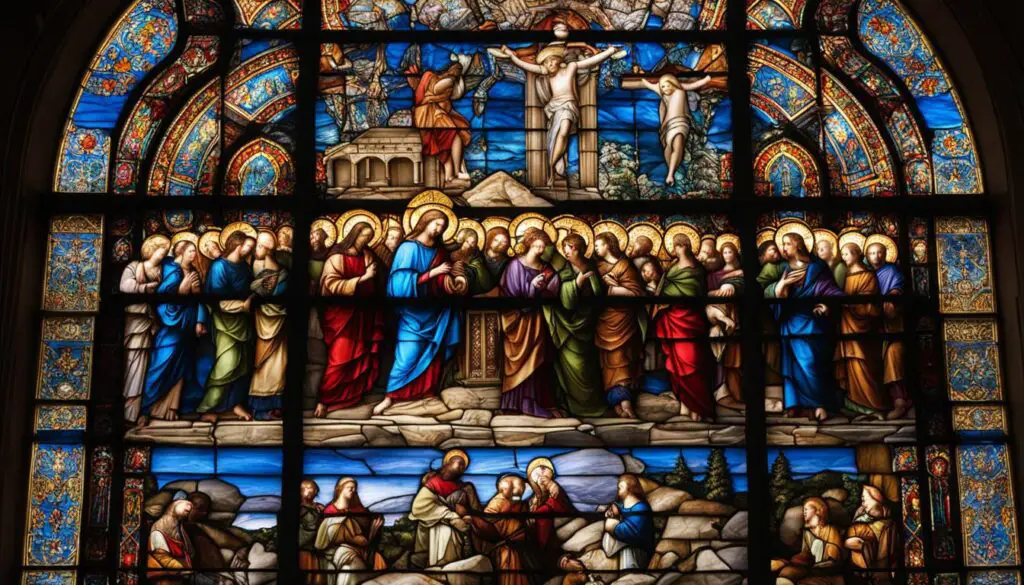
Modern Christianity: Challenges and Diversity
Modern Christianity faces a multitude of challenges in the ever-changing landscape of the 21st century. One of the significant challenges is the rise of secularism, a trend characterized by the decline in religious adherence and the increasing influence of non-religious perspectives. This shift in societal values has led many Christians to grapple with questions of faith, seeking ways to navigate their beliefs within a more secular context.
Another challenge that modern Christianity faces is the globalization of cultures and the resulting cultural diversity within the Christian community. As Christianity spreads to different regions of the world, it encounters unique cultural traditions, worldviews, and religious practices. This diversity brings both opportunities and challenges, as Christians strive to balance their core beliefs with cultural interpretations and expressions of faith.
“The world today is more interconnected than ever before, and this interconnection has brought various religious beliefs into close proximity. Christians find themselves in dialogue with people of different faiths, seeking common ground while respecting their distinct beliefs and practices.”
Furthermore, within Christianity itself, there is a significant degree of theological diversity and interpretation. Different denominations and theological traditions hold varying beliefs and practices, creating a rich tapestry of perspectives within the broader Christian faith. While this diversity can foster intellectual growth and vibrant discussions, it can also lead to disagreements and tensions within the Christian community.
The Challenges and Diversity of Modern Christianity
The challenges and diversity faced by modern Christianity require Christians to engage in critical reflection, open dialogue, and a willingness to adapt to the changing world. It necessitates a deeper understanding of the historical and cultural contexts in which Christianity exists, as well as a commitment to fostering unity amidst diversity.
| Challenges | Diversity |
|---|---|
|
|
By embracing these challenges and engaging with the diversity present within modern Christianity, believers have the opportunity to deepen their own faith, foster greater understanding and respect for others, and contribute positively to the wider world. Christianity continues to evolve and adapt, and its ability to navigate these challenges and foster unity amidst diversity will play a crucial role in its ongoing relevance and impact.
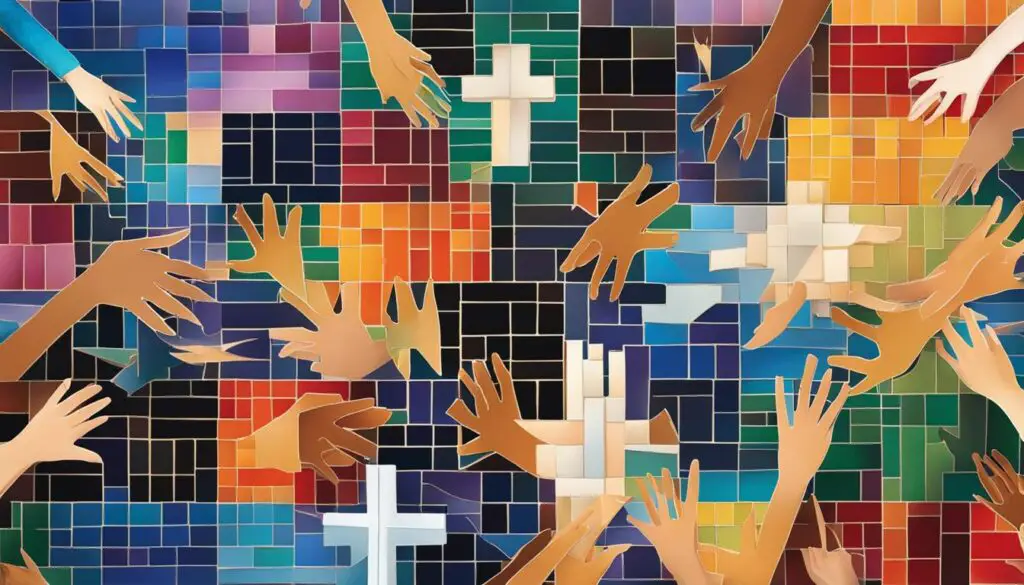
Christianity’s Enduring Legacy
Christianity has left an indelible mark on human history, its influence reaching far beyond its origins in the first century. The enduring legacy of Christianity is evident in various aspects of society, including art, culture, ethics, and social justice. Its teachings of love, compassion, and forgiveness continue to inspire individuals and shape communities worldwide.
One of the most profound ways in which Christianity has made its mark is through its impact on art and culture. From the magnificent cathedrals of Europe to the awe-inspiring paintings of the Renaissance, Christian themes and motifs have permeated and influenced artistic expression for centuries. The enduring beauty and significance of religious art attest to the lasting legacy of Christianity.
Furthermore, Christianity has played a pivotal role in shaping ethical systems and guiding moral principles. The teachings of Jesus Christ, with their emphasis on love for one’s neighbor, have inspired countless individuals to work towards social justice and alleviating the suffering of others. The concept of human dignity and equality, rooted in Christian beliefs, has had a profound impact on the development of human rights and the pursuit of equality.
Christianity’s enduring legacy is not confined to the realms of art and ethics. Its message of hope and redemption has touched the lives of billions of people throughout history, providing comfort and guidance in times of turmoil and uncertainty. The transformative power of Christianity continues to resonate with individuals seeking meaning and purpose in their lives.
As the world continues to evolve, Christianity adapts and persists, remaining relevant in ever-changing times. Its enduring legacy is a testament to the enduring power of faith and its ability to shape the course of human history. The impact of Christianity can be felt in the lives of individuals and the fabric of societies worldwide, making it a truly transformative and influential force.

| Aspect | Impact |
|---|---|
| Art and Culture | Christian themes and motifs have inspired and influenced artistic expression throughout history. |
| Ethics and Social Justice | Christian teachings have shaped moral principles and advocacy for social justice. |
| Personal Transformation | Christianity offers hope, redemption, and guidance to individuals seeking meaning and purpose. |
Early Church History Timeline
The timeline of early Church history provides a chronological overview of the significant events and milestones that shaped the development of Christianity from its beginnings in the first century to the medieval period and beyond. This timeline highlights key moments in the journey of the early Church, showcasing its growth, challenges, and enduring impact.
The Life of Jesus Christ (c. 4 BC – c. 30 AD)
The timeline begins with the life of Jesus Christ, the central figure of Christianity. Born in Bethlehem, his teachings and miracles attracted a devoted following. His crucifixion and resurrection form the cornerstone of Christian faith and mark the beginning of the early Church.
Formation of the Early Christian Church (33 AD – 100 AD)
Following Jesus’ ascension, his disciples, led by Peter and Paul, spread his teachings and established Christian communities. The early Christian Church faced persecution under Roman rule, but its growth was fueled by the dedication and evangelism of its members.
Rise of Christian Influence under Emperor Constantine (4th century AD)
Emperor Constantine’s conversion to Christianity in the early 4th century signaled a turning point for the faith. With the Edict of Milan in 313 AD, Christianity was legalized, ending centuries of persecution. Constantine’s support led to the spread of Christianity throughout the Roman Empire and marked the beginning of its influence on politics and society.
The Great Schism (1054 AD)
The 11th century witnessed a significant split between the Roman Catholic Church in the West and the Eastern Orthodox Church. The Great Schism resulted from theological differences and cultural and political tensions, leading to the establishment of distinct traditions and practices in the Western and Eastern branches of Christianity.
The Crusades (11th – 13th centuries AD)
The Crusades were a series of military campaigns undertaken by Christians in Europe to recapture the Holy Land from Muslim rule. These holy wars had a profound impact on both Christian and Muslim societies, fueling religious fervor, cultural exchange, and political changes.
The Reformation and the Birth of Protestantism (16th century AD)
The 16th-century Reformation, led by Martin Luther and other reformers, challenged the authority and practices of the Roman Catholic Church. This movement gave rise to Protestantism, a diverse branch of Christianity that emphasized individual interpretation of the Scriptures and brought about lasting changes in religious, social, and political spheres.
Modern Challenges and Diversification of Christianity (17th century AD – present)
In the modern era, Christianity has faced various challenges, including the rise of secularism and the emergence of new religious movements. The Protestant Reformation also spawned the formation of numerous denominations, contributing to the diversification of Christian beliefs, practices, and worship styles.
As Christianity has continued to evolve, its enduring legacy can be observed in the ways it has shaped art, culture, and society, leaving an indelible mark on human civilization.
Table: Early Church History Timeline
| Period | Key Events |
|---|---|
| c. 4 BC – c. 30 AD | The life and ministry of Jesus Christ |
| 33 AD – 100 AD | Formation and growth of the early Christian Church |
| 4th century AD | Emperor Constantine embraces Christianity, leading to the legalization of the religion |
| 1054 AD | The Great Schism divides the Roman Catholic and Eastern Orthodox Churches |
| 11th – 13th centuries AD | The Crusades |
| 16th century AD | The Protestant Reformation |
| 17th century AD – present | Modern challenges and diversification of Christianity |
Conclusion
The journey through early Church history reveals the origins, growth, and lasting impact of Christianity. From the life and teachings of Jesus Christ to the struggles and triumphs of the early Christians, this faith has left an indelible mark on individuals and societies throughout the ages.
By delving into the roots of Christianity, we gain a deeper understanding of its role in shaping human civilization. The teachings of compassion, forgiveness, and love have inspired generations and continue to resonate in our lives today.
From its humble beginnings as a small Jewish sect, Christianity has grown into a global religion with billions of believers. Its enduring legacy is evident in the cultural influence it has had on art, architecture, literature, and music.
As we reflect on early Church history, we are reminded of the power of faith and its ability to transform lives. The story of Christianity is a testament to the enduring impact of its teachings and the profound ways in which it has shaped the world we live in.
FAQ
What is the origin of Christianity?
Christianity originated from the life, teachings, death, and resurrection of Jesus Christ in the first century.
How did Christianity spread during its early years?
After Jesus’ crucifixion, his disciples formed the early Christian community and spread his teachings, establishing churches.
Did Christians face persecution in the early centuries?
Yes, Christians faced severe persecution from the Roman Empire, but they continued to grow due to their dedication and resilience.
Who played a significant role in the legalization of Christianity?
Emperor Constantine embraced Christianity in the early fourth century, leading to the legalization of the religion and its rise in influence.
What caused the division between the Eastern Orthodox Church and the Roman Catholic Church?
The Great Schism in the eleventh century resulted from theological disagreements, cultural differences, and political tensions.
What were the Crusades?
The Crusades were a series of holy wars undertaken by Christians to secure control of holy sites in the Middle East.
How did the Reformation impact Christianity?
The Reformation, led by Martin Luther in the 16th century, challenged the authority and practices of the Roman Catholic Church, giving birth to Protestantism.
How has Christianity influenced art and culture?
Christianity has inspired art, architecture, literature, and music, with notable works like the frescoes of the Sistine Chapel and hymns composed by Johann Sebastian Bach.
What are the challenges facing modern Christianity?
Modern Christianity faces challenges such as the rise of secularism, globalization, and the diversification of denominations and theological viewpoints.
What is the enduring legacy of Christianity?
Christianity’s enduring legacy lies in its profound impact on individuals and societies, shaping human civilization through its teachings of compassion, forgiveness, and love.
Can you provide a timeline of early Church history?
Early Church history spans from the first-century origins of Christianity to the medieval period and beyond, encompassing key events like the life of Jesus, the formation of the early Church, the Great Schism, the Crusades, and the Reformation.

